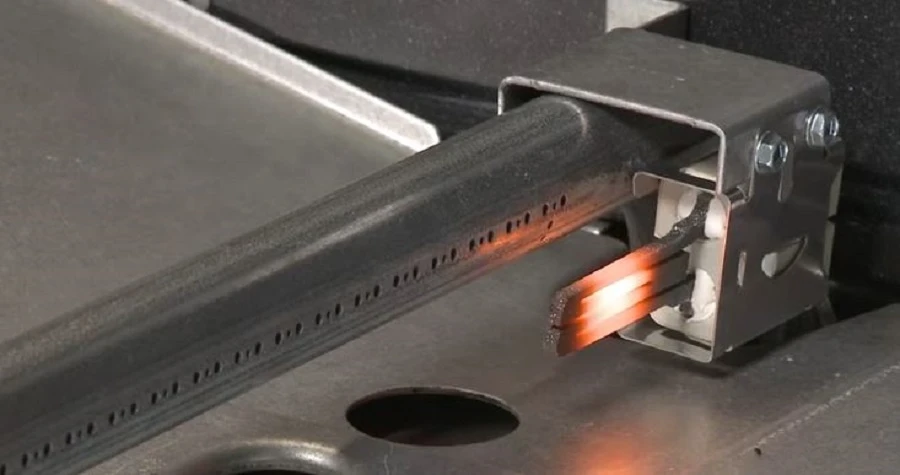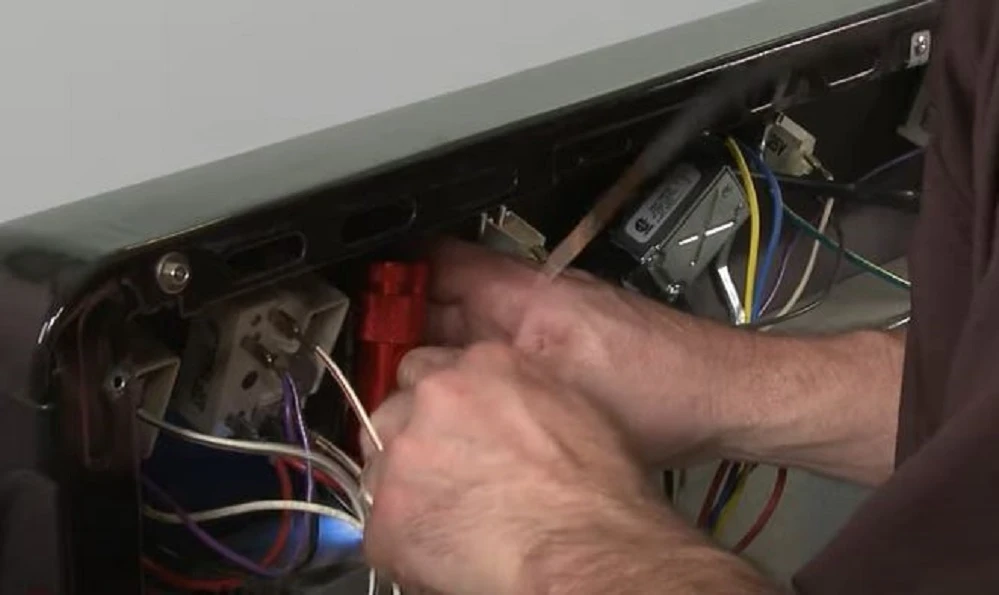| Note: This article may contain affiliate links, which means if you make a purchase following our links won’t cost you extra, but we may earn a commission. Learn more |
Baking in a gas oven presents unique challenges and opportunities. Achieving even baking and the perfect crust can be more complex due to the nature of gas heating. Gas ovens often create hot spots and a humid environment, which can affect the texture and finish of baked goods.
Common issues with gas ovens include inconsistent temperature, uneven heating, and delayed preheating. These problems arise because gas ovens distribute heat differently than their electric or convection counterparts. The combustion process in a gas oven releases moisture, making the oven’s interior more humid.
This increased humidity can interfere with achieving the desired browning and crisping of certain foods. Moreover, older gas ovens are notorious for having hot spots, which can cause uneven baking.
To combat these challenges, here are some practical tips: Ensuring your baking surface is flat is essential for even cooking. Allowing your baked goods to cook slightly longer can compensate for temperature inconsistencies.
Placing items on the upper rack can help achieve a better bake, as heat rises. Using a second baking plate can also improve heat distribution.
Lastly, rotating your dishes during baking can mitigate the effects of hot spots, promoting more uniform cooking.
6 Possible Causes and Solutions
Baking with a gas oven can introduce specific challenges, often distinct from those encountered with electric or convection ovens. Below are six possible causes for baking issues in gas ovens, alongside solutions to each, ensuring better outcomes for your baking endeavors.
1. Inconsistent Temperature Control
Gas ovens can sometimes struggle with maintaining consistent temperatures, which is vital for baking. This issue often stems from an outdated or malfunctioning thermostat, leading to undercooked or overcooked items.
The solution involves checking the oven’s thermostat accuracy with an oven thermometer. If discrepancies are found, recalibrating the thermostat or replacing it might be necessary.
Keeping the oven door closed as much as possible during baking also helps maintain a stable temperature.
2. Uneven Heating and Hot Spots
Uneven heating is a common complaint with gas ovens, attributed to the natural flow of gas and air, which can create areas of intense heat.
To counteract this, placing a pizza stone or baking steel in the oven to absorb and redistribute the heat more evenly can be beneficial.
Rotating baking trays halfway through the cooking time also helps ensure that all parts of the dish receive equal heat exposure.

3. Excessive Humidity
The combustion process in gas ovens produces moisture, which can prevent the exterior of baked goods from becoming crisp.
To solve this problem, slightly opening the oven vent, if available, or cracking the oven door open for a few seconds during the final minutes of baking can help release excess moisture.
Using a baking stone can absorb some of the moisture, promoting a crisper crust.
4. Delayed Preheating
Gas ovens can take longer to preheat to the desired temperature, affecting the baking process. Ensuring your oven is properly calibrated and giving it ample time to preheat fully before placing items inside is crucial.
For accuracy, use an oven thermometer to verify the internal temperature has reached the set point before beginning to bake.
5. Ignition Failure
Sometimes, the oven may not heat up at all due to ignition failure. This can be due to a faulty igniter or gas supply issues.
Checking the igniter for signs of wear or damage and replacing it if necessary can resolve this issue. If the igniter appears in good condition, consulting a professional to examine the gas supply line might be required.

6. Oven Door Seal Leaks
Heat escaping from the oven due to worn or damaged door seals can lead to inefficient baking.
Inspecting the oven door seal for any signs of damage and replacing it if defects are found can prevent heat loss. This ensures that the oven retains its set temperature more effectively, providing a consistent baking environment.
How to Use a Gas Oven for Baking?
Mastering the art of baking with a gas oven requires attention to detail and an understanding of how these appliances distribute heat. Given the unique characteristics of gas ovens, such as their tendency to produce a moist heat and have uneven hot spots, certain adjustments and practices can greatly improve baking results.
Essential tools for this include an oven thermometer to monitor temperature accurately, baking stones or steel to distribute heat evenly, and a good quality oven mitt to handle hot bakeware safely.
Step 1: Preheat the Oven Thoroughly
Always allow your gas oven to preheat before baking. This step is crucial as it ensures the oven reaches the desired temperature for an even bake. Depending on the oven, preheating can take anywhere from 10 to 20 minutes. Utilize an oven thermometer to verify the internal temperature matches your setting, as the built-in thermostat may not always be accurate.
Step 2: Use Baking Stones or Steels
To mitigate hot spots and uneven heating, place a baking stone or steel on the bottom rack. These tools absorb and radiate heat evenly, creating a more uniform baking environment. They are particularly beneficial for baking bread, pizza, and pastries that benefit from a quick, crisp bottom.
Step 3: Monitor and Adjust Oven Temperature
Given that gas ovens can fluctuate in temperature, periodically check the oven thermometer throughout the baking process. If you notice significant deviations, adjust the oven settings accordingly. This vigilance helps in maintaining the right baking environment for your dishes.
Step 4: Rotate Bakeware
Halfway through the baking time, rotate your pans 180 degrees to counteract uneven heating. If you’re baking on multiple racks, also switch the pans between the racks. This practice ensures that all sides of your baked goods cook evenly, preventing one side from becoming too brown or undercooked.
Step 5: Manage Oven Humidity
To control excess moisture common in gas ovens, slightly open the oven door for a few moments during the last minutes of baking, especially for goods where a crispy exterior is desired. Be cautious not to let too much heat escape. For items requiring a moist environment, like certain cakes, this step can be skipped.
Step 6: Keep the Oven Door Closed
Resist the urge to frequently open the oven door to check on your baking. Opening the door causes temperature fluctuations and can lead to uneven baking. Instead, rely on the oven light and window to monitor progress as much as possible.
Step 7: Regular Oven Maintenance
Ensure your gas oven is functioning optimally by keeping it clean and having it serviced regularly. Check the seal on the oven door to make sure it’s not letting heat escape and replace it if necessary. Keeping burners clean and free from obstruction allows for better gas flow and more even heating.
Baking in a Gas Oven vs Electric
The debate between gas and electric ovens has long existed in the baking community, with each type of oven offering distinct advantages and challenges. Gas ovens, for instance, heat up quickly and offer a moist baking environment, which can be advantageous for certain baked goods.
This moisture comes from the combustion of gas, which releases water vapor into the oven. As a result, items like roast and bread can benefit from this moisture, as it can lead to juicier meats and a nice crust on bread.
However, this same feature can be detrimental for baked goods that require a dry heat to achieve a crisp texture.
Electric ovens, on the other hand, tend to have a drier heat, which is excellent for achieving golden-brown finishes on items such as cookies and pies. The heat in electric ovens is also generally more even, which reduces the need for rotating pans or using baking stones.
Electric ovens usually take longer to preheat and may not reach the same high temperatures as quickly as gas ovens.
Adapting recipes to suit the type of oven being used can greatly improve baking outcomes. For instance, in a gas oven, reducing the temperature by 25 degrees Fahrenheit compared to what an electric oven recipe calls for can prevent the edges of baked goods from overcooking before the center has fully baked.
Common Queries on Gas Oven Baking
Why Do My Baked Goods Dry Out?
Gas ovens can cause baked goods to dry out due to their mode of heating and air circulation. The combustion process in a gas oven naturally produces a moist environment, yet paradoxically, the outside of baked goods may dry faster than in electric ovens.
To combat this, place a shallow pan of water on the bottom rack of the oven to introduce more moisture into the air. This can help keep the surface of your baked goods from drying out too quickly, allowing the inside to cook thoroughly without losing too much moisture.
Is It Normal for the Oven Flame to Go On and Off?
Yes, it is normal for the oven flame in a gas oven to cycle on and off. This is part of the oven’s attempt to maintain the set temperature. When the oven reaches the desired temperature, the flame will temporarily go off and reignite to adjust for any temperature drops. Consistent cycling is a sign the oven is working correctly to keep a stable temperature.
However, if the flame goes out completely and doesn’t reignite, or if it seems to be off more than it’s on, there might be an issue with the thermostat or igniter.
Can I Bake on Multiple Racks at Once?
Baking on multiple racks in a gas oven can be challenging due to uneven heat distribution. However, it’s not impossible. To achieve the best results, rotate and swap the positions of the baking trays halfway through the cooking time. This rotation helps to expose all items to the oven’s various temperature zones equally.
Using convection mode if your oven has it, can improve air circulation and help with more even baking across multiple racks.
How Do I Adjust for Recipes Calling for Electric Ovens?
Recipes designed for electric ovens may need slight adjustments when used in a gas oven. Typically, reducing the oven temperature by 25 degrees Fahrenheit is a good rule of thumb to prevent overbaking.
Gas ovens often heat up faster and can have hotter spots, so monitoring your bake closely and adjusting the position of your dish in the oven can also help achieve the desired outcome. An oven thermometer is invaluable for making precise temperature adjustments.
Bottom Line
The nuances of baking with a gas oven can present a learning curve, but understanding these specific challenges unlocks the potential for excellent baking results. Key strategies include introducing moisture for drier bakes, rotating dishes for even cooking, and adapting recipes from electric to gas ovens. Each query addressed reveals more about the intricacies of gas oven use, underscoring the importance of observation, adaptation, and the right tools. With these insights, baking in a gas oven transforms from a daunting task to an achievable art, offering the satisfaction of perfectly baked goods through patience and practice.